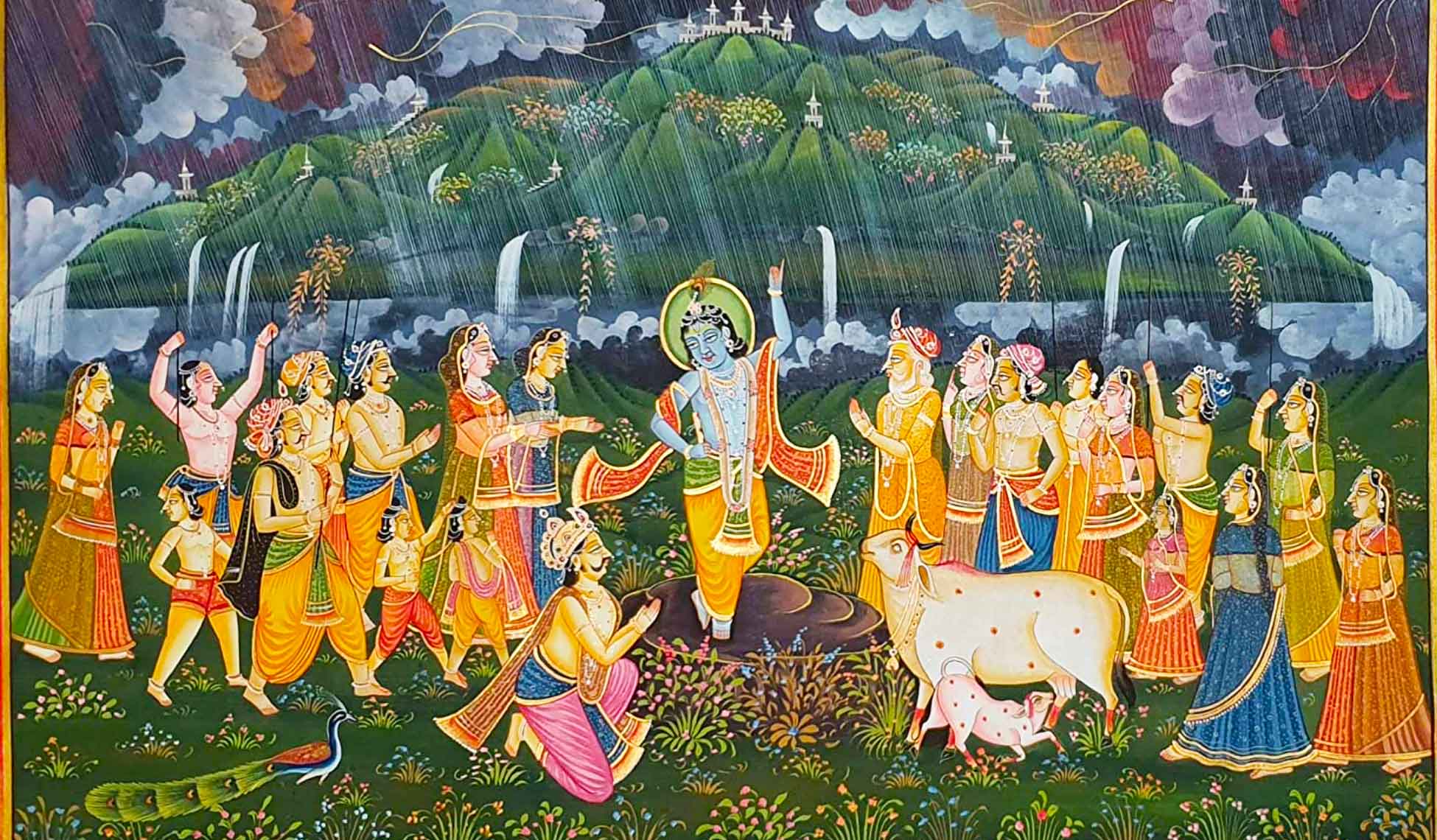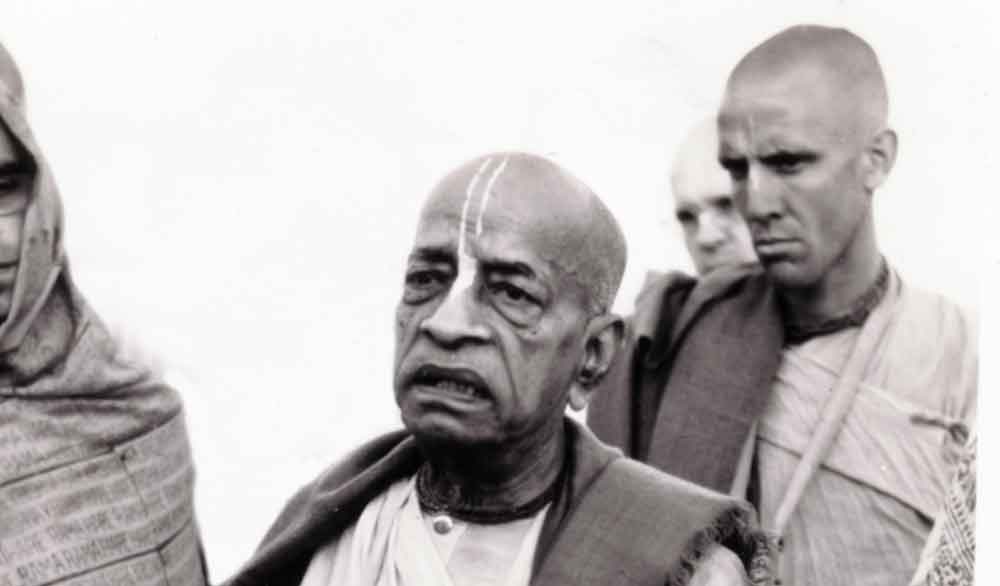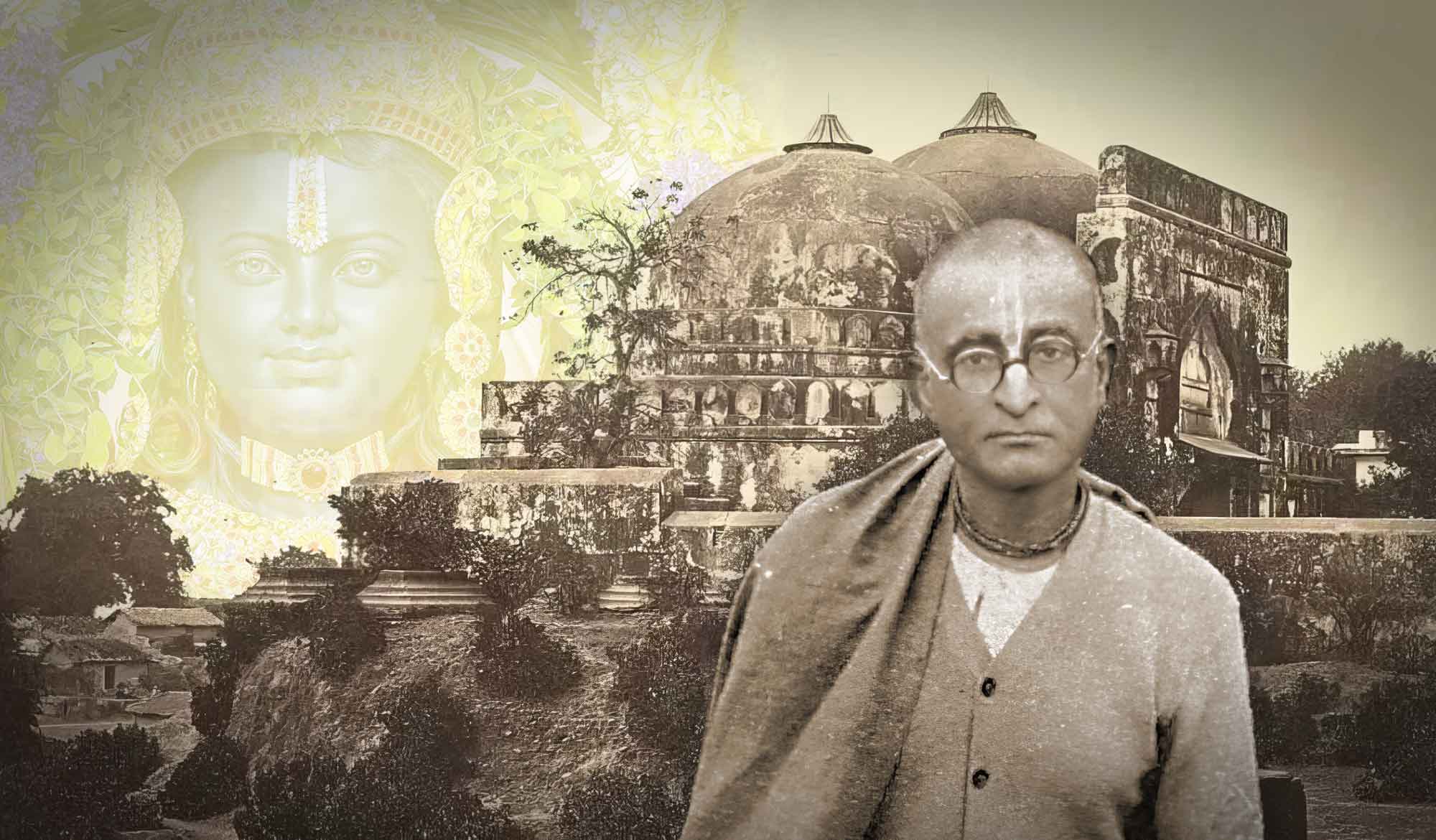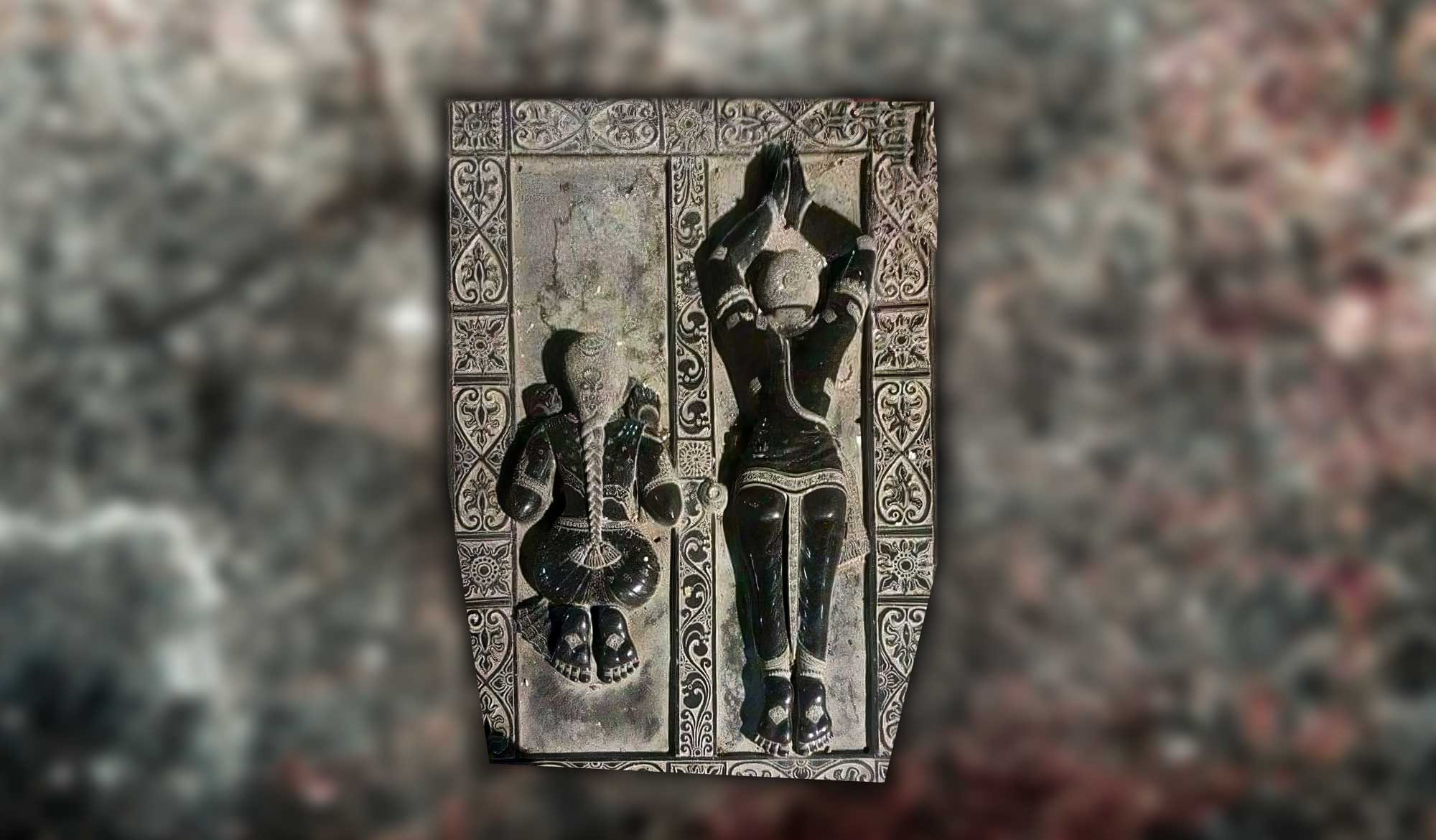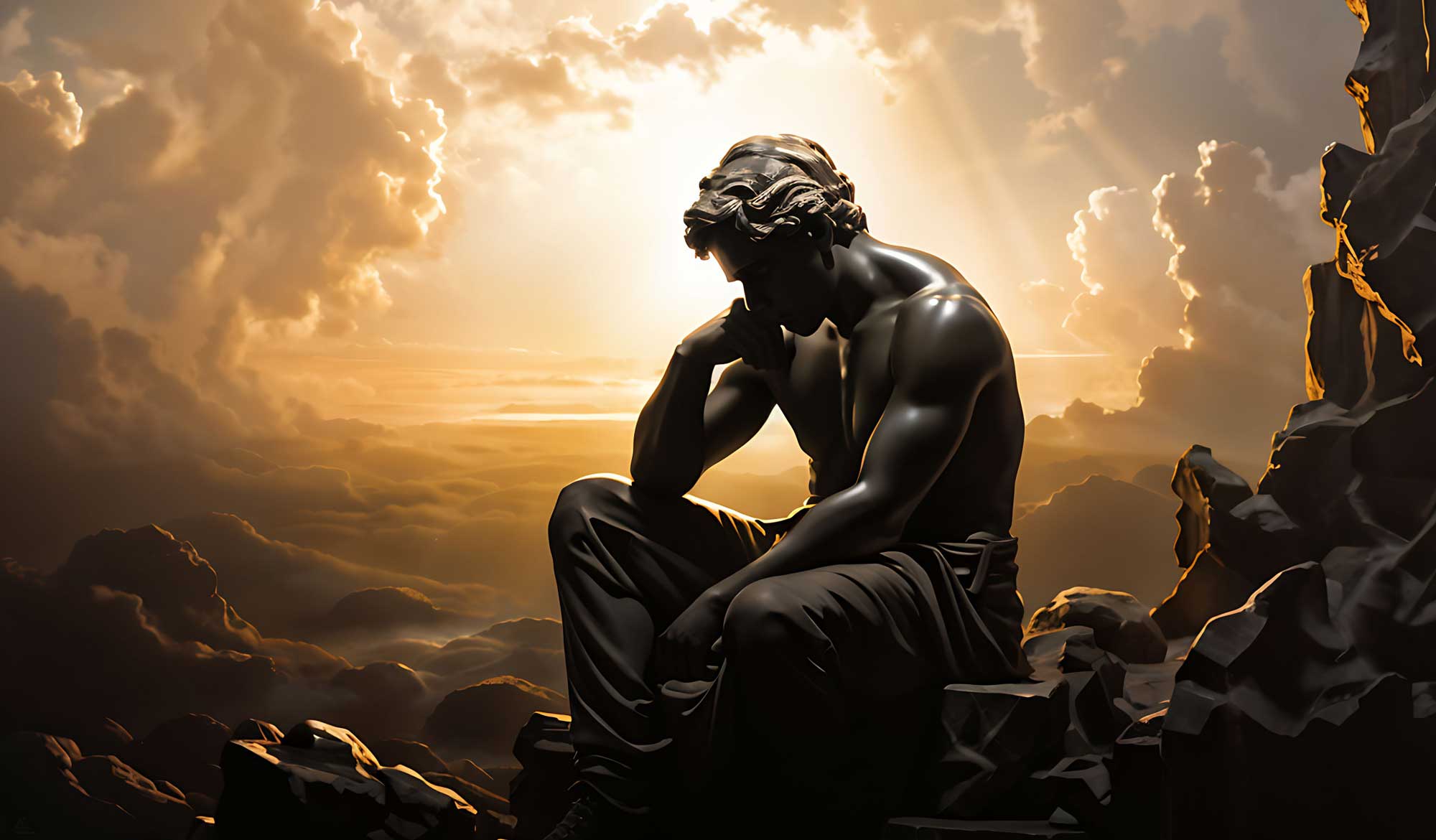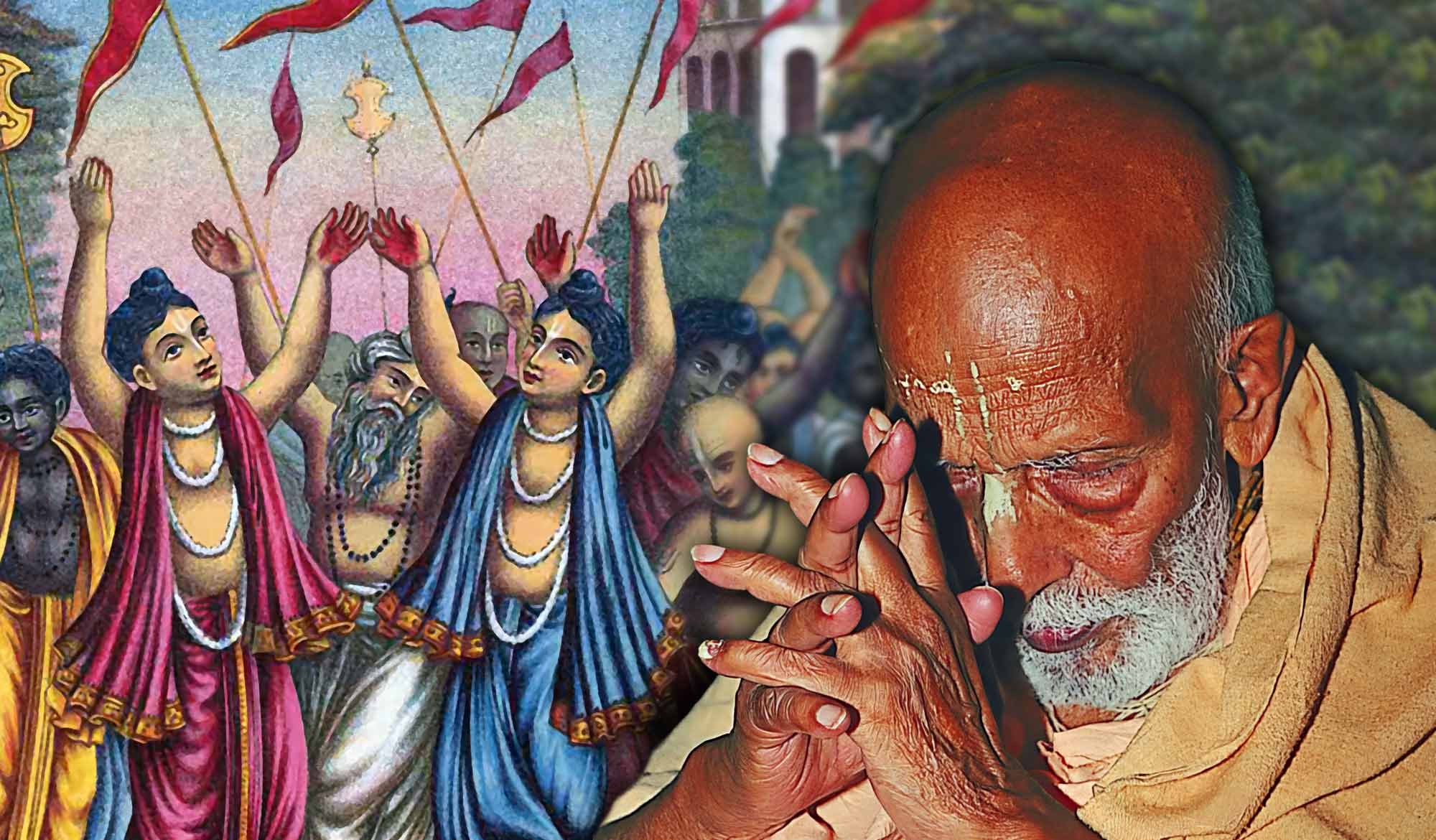Overview
The following talk was given by Śrīla Śrīdhara Mahārāja on the day of Govardhana Pūjā on 16th November 1982 at Śrī Caitanya Sārasvata Maṭha, Navadvīpa-dhāma, West Bengal. Śrīla Śrīdhara Mahārāja elaborates upon a śloka from the Śrīmad Bhāgavatam describing Kṛṣṇa's lifiting of Govardhana Hill.
deve varṣati yajña-viplava-ruṣā vajrāsma-varṣānilaiḥ
sīdat-pāla-paśu-striy ātma-śaraṇaṁ dṛṣṭvānukampy utsmayan
utpāṭyaika-kareṇa śailam abalo līlocchilīndhraṁ yathā
bibhrad goṣṭham apān mahendra-mada-bhit prīyān na indro gavām
(Bhāg. 10.26.25)
“May that Lord of the cows be satisfied by us. Who is Indra when compared to Kṛṣṇa? Kṛṣṇa is the master of Indra, and yet the Supreme Absolute Truth has accepted a simple position as the keeper of cows. Superficially, He is a mere cowherd boy, but let that cowherd boy who holds within Him the power of controlling the whole universe, be satisfied with us. We want to worship that Lord who has taken the humble position of the king of the cows.”
The very gist of the govardhana-līlā has been expressed in this śloka. Śukadeva Gosvāmī has inaugurated govardhana-līlā and Gopāla in this way. With all their might, the cowherd-kings used to perform some sacrifice for the satisfaction of Indra, the god of clouds, who is the controller of the subtle powers of nature, who is supposed to manage the necessary rain, by which the grass will grow, which becomes the foodstuff of their cows, buffaloes etc. Their main income was the cows. So many chiefs were there. They were not always having a permanent seat in one place, but according to the necessity of the grazing, they used to move from place to place in that vicinity. First Nanda was in Gokula when Kṛṣṇa was born – again he moved to Nandagrāma and he also moved to other places.
So many cow-keepers were under Nanda Mahārāja. When He was seven, Gopāla gave a proposal to the chiefs of the cow-keepers in a diplomatic way, “You are near Nandagrāma and the main fodder – the grass, the jungle, the creepers – the food of the cows, you mainly get from Girirāja-Govardhana. There is no necessity of worshipping or flattering that demigod Indra. Who is he? Rather you should make arrangements to worship Girirāja-Govardhana and stop the annual celebration of worshipping Indra.”
Anyhow, reluctantly and fearfully, they accepted the proposal of Gopāla because they heard that He was not an ordinary boy – He had some mystic background. Maharṣi Garga had come when the boy was about 6 months old to give His name. He told Nanda Mahārāja at the time of the ceremony that, “Your boy is not ordinary. He has His previous record. He was of a white colour in Satya-yuga, in Treta-yuga He was of a red colour and He also takes a yellow colour. Now He has come with a black colour.
āsan varṇās trayo hy asya gṛhṇato ‘nuyugaṁ tanūḥ
śuklo raktas tathā pīta idānīṁ kṛṣṇatāṁ gataḥ
“Your son Kṛṣṇa appears as an avatāra in every millennium. In the past He assumed three different colours—white, red and yellow. Now He has appeared in a blackish colour.” (Bhāg. 10.26.16)
Śuklo raktas tathā pīta – pīta means that it is reserved for Kali-yuga and it helps to understand that this avatāra is in disguise – Mahāprabhu. He is pītāvatāra, the yugāvatāra. Garga Muni said to Nanda, “There are four specific avatāras for four specific yugas. It is found that in Satya-yuga, the golden age, we have the four-handed white incarnation. It is also mentioned in Bhāgavatam and Mahābhārata etc. that in Treta-yuga He comes in a red colour to inaugurate the yuga-dharma – to instruct the general public what the special religious duty of that age will be. In Kali-yuga He also comes in a yellow colour to establish the yuga-dharma, and now that supernatural figure has come in a black colour.”
This was said by Garga to Nanda Mahārāja, and by some other incidents the cow-keepers came to the conclusion that, “This boy is mystical, mysterious – not an ordinary person like us.” Through the arguments of this boy and His influence, He made them accept His proposal. They stopped the yajña for the satisfaction of Indra, which had been done from a very, very early age by their predecessors, and the pūjā for Govardhana was added. They took all their prepared things to offer near Govardhana and at that time Kṛṣṇa showed some miracle – one hand appeared from the top of Govardhana and was taking those offerings. The cow-men were satisfied, but Indra came to know that one boy born in Vṛndāvana, who was said by some to have supernatural powers, had stopped his worship. “He has stopped my regular worship, that the milkmen were doing for such a long time. It cannot be tolerated silently. I must try to teach them a lesson so that they may not venture to stop.” He ordered all the subtle natural powers, “Go and devastate the whole of Vraja-bhūmi”
deve varṣati yajña-viplava-ruṣā vajrāsma-varṣānilaiḥ
sīdat-pāla-paśu-striyātma-śaraṇaḿ dṛṣṭvānukampy utsmayan
utpāṭyaika-kareṇa śailam abalo līlocchilīndhraḿ yathā
bibhrad goṣṭham apān mahendra-mada-bhit prīyān na indro gavām
(Bhāg. 10.26.25)
Deve varṣati yajña-viplava-ruṣā – the gods were enraged by the stopping of their sacrifice, which was directed for their satisfaction. They were very much excited. “A revolutionary step has been taken! For such a long time they were performing this sacrifice and now they have suddenly stopped! So much courage! They must reap the result!” It began to rain profusely.
Vajrāsma-varṣānilaiḥ – vajra means thunder and asma means hail. Storm, hail, rain and thunder were ordered to demolish the whole of Vṛndāvana.
Sīdat – they were very much troubled and distressed. Suffering and exhausted they came to Kṛṣṇa.
Pāla-paśu – the keepers of the cows and the cows themselves.
Striya – the women also were very much afflicted.
Śaraṇam – they took refuge under His feet. “Now save us from this danger! What You have ordered we have done, but now save us from this dangerous position. The whole of Vraja is going to be finished.”
Dṛṣṭvānukampya – seeing this, Kṛṣṇa felt a little pity.
Utsmayam – and smiled a little.
Utpāṭyaika-kareṇa śailam – immediately He uprooted Govardhana Hill with one hand.
Abalo – just like a young boy.
Līlo – a playing ball. Just as a young child takes his playing ball, without any exertion, He took that big hill with just one hand.
Gostham apan – the city where the cows live and accordingly the cow-keepers also is known as goṣṭha.
Mahendra mada-bhit – He saved them from the madness, or the intoxication, of Indra, the King of the gods. In this way He cowed down that great king of heaven. Indra is known as Mahendra – the commander and controller of great resources.
Prīyān na indro gavām – In this way, our King of the cow-keepers, brought Indra. the big King of the heaven, to kneel. Indra has got extensive power over the subtle potencies of the world, and the King of the cowboys brought him to his knees. Let him be propitiated! May He be pleased with us fallen souls.
In this way the story begins – a very wonderful thing for a boy of seven. One may say, “This cannot be relied upon.” Come with trust! He is the controller of everything. In other cases also, He showed miracles to Brahma and others who opposed. He is the Master of miracles. It came to my mind that scientifically, if it is possible to stop the gravity of the earth, then there will be no weight – then it is possible that like a playing ball it can be taken up and kept there. It is by His will power – “Let there be water!” There was water! “Let there be light!” There was light! Will power is at the root of everything. What is at the root of what we see and what we feel? Universal will! That is modified by our crude, small, individual will. If the universal will is withdrawn, everything is dark. All comes from the subjective world. The magician controls the subject and can show anything and everything and then, when we come back into the world of science, we feel as if we have been deceived by the magician. But at the time we are helpless. The seer is controlled, not the seen. By control, the dṛṣṭa, the subject, can show anything and everything – “See this! See that!”
When Kṛṣṇa enters the playground of Kaṁsa, different sections of people see Him differently because He is showing Himself to them in a different way. He is controlling. He is the Super Controller and we are submissive subjects of a lower order. The subjects of a higher order can influence the subjective particles of a lower order. The world is such that from the subtle, it comes to the conception of the gross. Everything is possible if we have a conception of God, the Controller of all, and how He is fully independent. Everything is designed and destined by Him. We have to see that past and future are in His consciousness everywhere. We think it is impossible, but all this presupposes that the cause of the world is one perfect, omniscient, omnipotent, all-loving Absolute. If we inspect carefully every day, we shall come to such a thing that everything is wonderful! Any research by the scientific method is astonishing, but it is already there and the Creator and Protector of the whole world is in the background. He is endowed with omniscience and omnipotence. We are not masters. We are finding only a point of astonishment. At every point we find a new thing with astonishment. We are astounded. So many astounding researches are being made – still, we cannot think that the source, the keeper and the protector of all these astounding incidents is perfect. We can’t advance so far. We are always suffering from the disease of vipralipsā – self-deception. Everything is producing some astonishment, still I won’t admit that the cause is outside and He is some perfect principle that can do anything and everything. Our scientific knowledge won’t allow that. Our credit will be buried underground. No credit is there and as His instrument we are doing anything and everything. There is no individual credit for a scientific research scholar – so there is self-deception.
At the time of the govardhana–līlā, Kṛṣṇa accepted what was offered to Him as if a hand was coming and He was taking everything. Thereby it is shown that Govardhana is another aspect of Kṛṣṇa Himself. The vraja–rasa Vaiṣṇava is attached to the vraja-rasa vṛndāvana-līlā of Svayam-Bhagavān. They take that particle (stone) of Govardhana. Any part of the Infinite is also infinite. That which is seen by us as a particle of Govardhana is also Govardhana. He is fully represented there. It is seen by the practices of the great mahājanas, including Mahāprabhu Himself who gave govardhana–śilā to Dāsa Gosvāmī, and Dāsa Gosvāmī understood that govardhana–śilā is Kṛṣṇa Himself. He was also inspired to think that the guñja–mālā ornament around Kṛṣṇa is Rādhārāṇī – to beautify, to serve and to please Him. That aspect comes from Rādhārāṇī. In this way Dāsa Gosvāmī began the worship of govardhana–śilā, and thence the Gauḍīya Vaiṣṇavas generally accept govardhana–śilā as a representation of Kṛṣṇa. This is related in the Bhāgavatam and we also know through Mahāprabhu by His giving a govardhana–śilā to Dāsa Gosvāmī. Though he was the son of a very rich man, at that time Dāsa Gosvāmī. was a beggar in the street and he used to worship govardhana–śilā and the guñja-mālā – Kṛṣṇa and Rādhā – only with tulasī and water. The only materials of worship were water and tulasī. Bhāva-grāhī janārdana – this is the medium through which the bhāva, the internal feeling of worship, goes to the Eternal Cause of beauty and love. That is the medium by which He Himself has established that, “I am this Govardhana!”
Related Articles and Books
- Śrī Dāmodara Kathā – The History of Rādhā Dāmodara Temple (Book)
- Kṛṣṇa-tattva (The Fundamental Reality of Śrī Kṛṣṇa) by Śrīla Bhaktisiddhānta Sarasvatī Ṭhākura
- The Ontological Position of Śrī Śrī Rādhā-Govinda by Śrīla Bhakti Rakṣaka Śrīdhara Deva Gosvāmī
- Śrī Govardhana Pūjā by Śrīla Bhakti Rakṣaka Śrīdhara Deva Gosvāmī
- Śrī Narasiṁha Caturdaśī by Śrīla Bhakti Rakṣaka Śrīdhara Deva Gosvāmī
- Śrī Śrī Rādhā Kṛṣṇa – The Fountainhead of All Tattvas by Śrīla Bhakti Pramoda Purī Gosvāmī
- Kṛṣṇa – The Supreme Vedāntist by Śrīla A.C. Bhaktivedānta Swami Prabhupāda
- Dāsa Gosvāmī and the Unique Position of Govardhana by Śrīla Bhakti Gaurava Narasiṅgha Mahārāja
- The Worship of Govardhana by Śrīla Bhakti Gaurava Narasiṅgha Mahārāja
- Śrī Kṛṣṇa Janmāṣṭamī by Śrīla Bhakti Gaurava Narasiṅgha Mahārāja
- Questions and Answers on Baladeva Tattva by Śrīla Bhakti Gaurava Narasiṅgha Mahārāja
- The Worship of Lord Narasiṁha by Śrīla Bhakti Gaurava Narasiṅgha Mahārāja
- The Dawn of the Age of Love? by Śrīla Bhakti Gaurava Narasiṅgha Mahārāja
Further Reading
- Śrī Kṛṣṇa Saṁhitā by Srila Bhaktivinoda Thakura (Book)
- Impersonal Spirituality and Transcendental Spirituality by Śrīla Bhaktivinoda Ṭhākura
- Servitorship to Kṛṣṇa by Śrīla Bhaktivinoda Ṭhākura
- The Glories of Puruṣottama Māsa by Śrīla Bhaktivinoda Ṭhākura
- Identifying the Supreme Object by Śrīla Bhaktivinoda Ṭhākura
Prabhupāda Śrīla Sarasvatī Ṭhākura’s Visit to Ayodhyā
With the forthcoming observance of Śrī Rāma Navamī, we present 'Prabhupāda Śrīla Sarasvatī Ṭhākura’s Visit to Ayodhyā' written by Śrīla Bhaktisiddhānta Sarasvatī Ṭhākura Prabhupāda from The Gaudīyā magazine, Vol 3. Issue 21/ In December 1924, after visiting Benares and Prāyāga, Sarasvatī Ṭhākura visited the birth-site of Śrī Rāmācandra in Ayodhyā.
Śaraṇāgati – The Only Path to Auspiciousness
In this article, 'Śaraṇāgati - The Only Path to Auspiciousness', Dhīra Lalitā Dāsī analyses the process of śaraṇāgati (surrender) beginning with śraddhā (faith). She also discusses the role of śāstra and the Vaiṣṇava in connection with surrender.
Ātma Samīkṣā – The Value of Introspection
In this article, "Ātma Samīkṣā – The Value of Introspection" Kalki Dāsa highlights the importance of introspection in the life of a devotee and especially in relation to the worldly environment that surrounds us. He also explains how transcendental sound influences our capacity to introspect.
Svasti No Gaura-vidhur Dadhātu (May the Moon-like Gaura Bestow Auspiciousness)
This Bengali poem, ‘Svasti No Gaura-vidhur Dadhātu,’ (May the Moon-like Gaura Bestow Auspiciousness) written by Śrīla Bhakti Pramoda Purī Gosvāmī, was first published in 1965 in Caitanya Vāṇī magazine, Vol.5, Issue 1. In this composition, Śrīla Purī Mahārāja gives advice to the fallen jīvas to sincerely accept Mahāprabhu's gift of the Holy Name. This poem was translated into English by Sanātana Dāsa and Parameśvarī Devī Dāsī.
Prabhupāda Śrīla Sarasvatī Ṭhākura’s Visit to Ayodhyā
With the forthcoming observance of Śrī Rāma Navamī, we present 'Prabhupāda Śrīla Sarasvatī Ṭhākura’s Visit to Ayodhyā' written by Śrīla Bhaktisiddhānta Sarasvatī Ṭhākura Prabhupāda from The Gaudīyā magazine, Vol 3. Issue 21/ In December 1924, after visiting Benares and Prāyāga, Sarasvatī Ṭhākura visited the birth-site of Śrī Rāmācandra in Ayodhyā.
Śaraṇāgati – The Only Path to Auspiciousness
In this article, 'Śaraṇāgati - The Only Path to Auspiciousness', Dhīra Lalitā Dāsī analyses the process of śaraṇāgati (surrender) beginning with śraddhā (faith). She also discusses the role of śāstra and the Vaiṣṇava in connection with surrender.
Ātma Samīkṣā – The Value of Introspection
In this article, "Ātma Samīkṣā – The Value of Introspection" Kalki Dāsa highlights the importance of introspection in the life of a devotee and especially in relation to the worldly environment that surrounds us. He also explains how transcendental sound influences our capacity to introspect.
Svasti No Gaura-vidhur Dadhātu (May the Moon-like Gaura Bestow Auspiciousness)
This Bengali poem, ‘Svasti No Gaura-vidhur Dadhātu,’ (May the Moon-like Gaura Bestow Auspiciousness) written by Śrīla Bhakti Pramoda Purī Gosvāmī, was first published in 1965 in Caitanya Vāṇī magazine, Vol.5, Issue 1. In this composition, Śrīla Purī Mahārāja gives advice to the fallen jīvas to sincerely accept Mahāprabhu's gift of the Holy Name. This poem was translated into English by Sanātana Dāsa and Parameśvarī Devī Dāsī.


